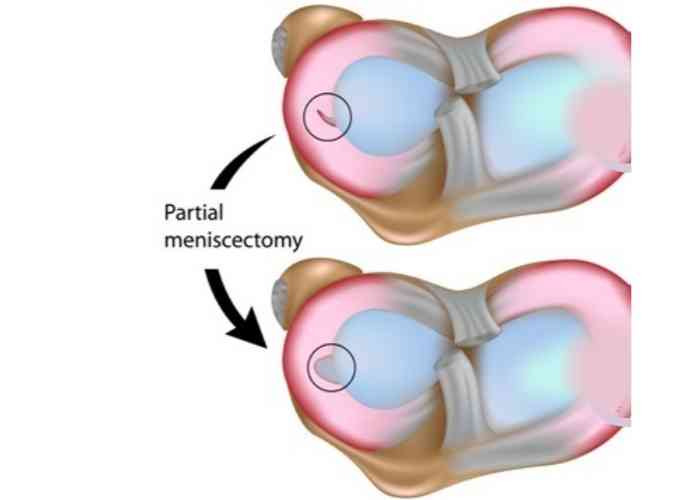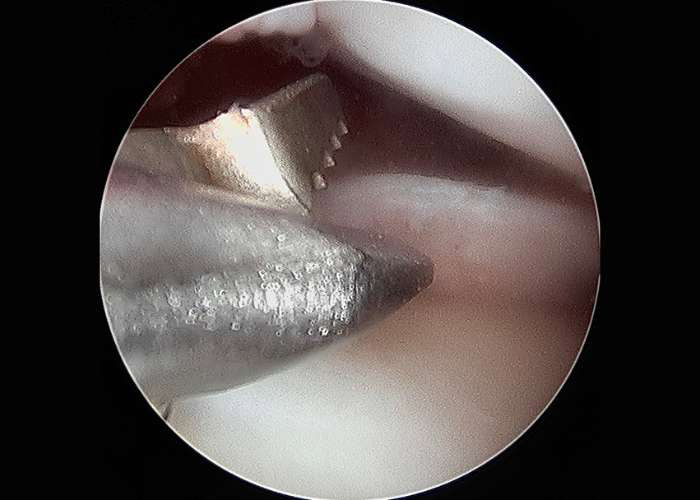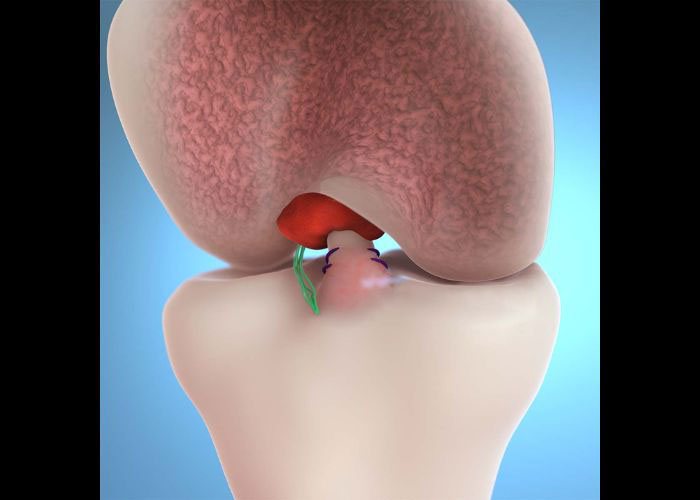What is a meniscus injury?
The meniscus is a tough and rubbery connective tissue in the form of a crescent-shaped disc within the knee joint. Each knee joint has two meniscus discs between the ends of the femur (thigh bone) and tibia (shin bone): a medial meniscus and a lateral meniscus. The meniscus tissue is different from the articular cartilage that covers the ends of these bones because it acts as a shock absorber rather than enabling joint movement. Even though the meniscus tissue is quite durable, it is still susceptible to injury. A meniscus injury occurs from a forceful knee rotation and more often affects athletes that participate in contact sports that involve bearing the body’s full weight on the knee. However, performing activities of daily living or experiencing a traumatic event, such as a exercising or playing sports, can also result in a meniscus injury. It should be noted that if a meniscus injury does not heal properly, or is left untreated, the likelihood of joint deterioration increases and can cause degenerative disorders such as osteoarthritis.
What is the treatment for a meniscus injury?
The meniscus has two distinct areas known as the “red zone” and the “white zone”. The “red zone” carries a profuse blood supply along the outer third portion of the meniscus cartilage that enables tissue repair with non-surgical therapies alone. The inner two-thirds “white zone” lacks this blood supply therefore injuries affecting this area often require surgical intervention. Surgical treatment for a meniscus injury is recommended for patients with an irreparably large tear, sudden knee instability is experienced following a traumatic incident, a “locking” or “catching” sensation occurs with joint movement, or those that did not respond well to non-surgical therapies. The goal of surgically repairing a meniscus injury is to minimize the risk of developing arthritis by preserving as much of the healthy meniscus tissue as possible. Dr. Ronak Mukesh Patel, orthopedic knee doctor, treats patients in Sugar Land, Pearland, and the Houston, Texas area, who have experienced a meniscus injury and are in need of surgical repair.

Does a meniscectomy remove the entire meniscus cartilage?
Dr. Patel takes a number of factors, such as the patient’s age, activity level, medical history, symptoms, tear location and size, and desires recovery outcomes, into consideration when formulating an appropriate treatment plan. A complete review of the magnetic resonance imaging (MRI) studies by Dr. Patel can help determine the best surgical approach to perform. Dr. Patel favors a meniscal repair which is determined by the tear type, tissue quality, age of patient, and cartilage health. In cases where a repair is not possible, a partial meniscectomy in which only the necessary amount of tissue is removed in order to successfully restabilize the knee joint. In some cases, Dr. Patel may remove a portion of the meniscus and repair tissue that is amenable. However, rarely, patients that experience larger or more complex meniscus injuries may require the entire meniscus to be removed, known as a full meniscectomy. By retaining as much of the native tissue as possible, the shock-absorbing ability of the meniscus is preserved, the likelihood of sustaining another meniscus injury is reduced, and the knee joint is protected from early osteoarthritis and cartilage breakdown.
How is a meniscectomy performed?
A partial meniscectomy is the most common outpatient surgery performed in the United States. This minimally invasive surgical procedure utilizes a small camera (arthroscope) for visualizing and methodically examining the soft-tissue structures of the knee joint. Once the meniscus injury is identified, Dr. Patel introduces specialized surgical instruments into the knee joint to complete the necessary revisions. The irreparably damaged tissue fragments are excised and any irregularities that can further irritate the meniscus cartilage, such as lesions, bone spurs, inflamed, or irregular tissues, are removed as well. The remaining healthy meniscus cartilage is re-attached in the correct anatomical position by special surgical anchors that are secured within the bone.

Meniscal biters for arthroscopic surgery

Arthroscopic view of meniscal biter being used
What is the recovery period like after a meniscectomy?
The recovery period following a meniscectomy can depend on the specific surgical technique implemented by Dr. Patel and the amount of native meniscus cartilage remaining. Patients use crutches for 2-5 days, are allowed full weight bearing, and do not need a brace. Full range of motion is achieved within 1-2 weeks of surgery. Most patients can expect a return to normal daily activities in approximately 2 to 4 weeks and sports in 2-3 months depending on prior fitness level. The patient’s compliance with the post-operative instructions provided by Dr. Patel can also greatly affect the recovery process. The expectations of patients in the Houston, Texas area following a meniscectomy are as follows:
- Weight-bearing, as tolerated, during the first week with the assistance of crutches or a walker. Full weight-bearing activities will slowly be introduced over the following 2 weeks.
- Management of post-operative pain and inflammation by a combination of rest, ice, and non-steroidal anti-inflammatory medications (NSAIDs).
- Because high-impact activities can aggravate joint pain and inflammation, patients that undergo a meniscectomy should consider only participating in lower-impact sports and other activities to prevent the development of osteoarthritis.
Meniscectomy Surgeon

Are you at risk of tearing your meniscus? Athletes or individuals who participate in activities that involve running and jumping can be at a higher risk of tearing their meniscus. Small or minor meniscus tears can often heal on their own without surgery, but larger tears, especially those in the inner third of the meniscus, may require surgical intervention to restore knee function. Knee meniscus surgeon, Doctor Ronak Mukesh Patel, provides diagnosis as well as surgical and nonsurgical treatment options for patients in Houston, Sugar Land, and Pearland, TX who have experienced a meniscus tear. Contact Dr. Patel’s team today!








